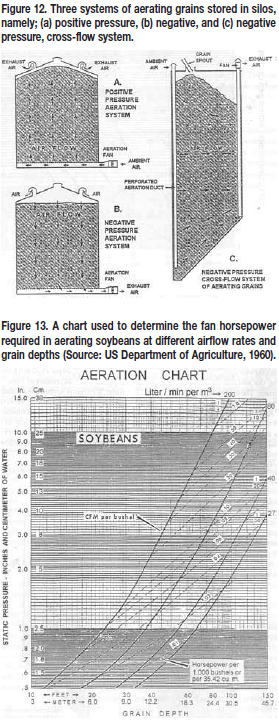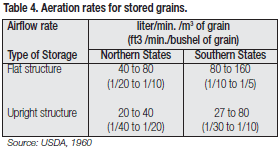Handling and Storage Of Soybeans and Soybean Meal: Part 5 - Maintenance Of Quality
Maintenance Of Quality
Once soybeans reach maturity and are harvested, their inherent quality is fixed and can only be maintained by proper drying, cleaning, and conditioning. Quality maintenance involves various operations that will provide environmental conditions that minimize the combined deteriorative effects of ambient temperature and moisture on both soybeans and soybean meal. It involves slowing down undesirable chemical changes from occurring, inhibiting mold and insect activity. The major elements in achieving this goal consist of a reliable temperature monitoring system, periodic drawing of product samples and accurately testing them, and having a reliable cooling or aeration system.
Temperature Monitoring
The most convenient property of stored grains to measure is temperature. In small farm storage silos,
one can use temperature probes to monitor grain temperature and can draw representative samples
simultaneously. However, in large commercial silos, the use of thermocouple wires and multi-point
potentiometer for remote temperature sensing is standard and essential. Modern grain storage silos
are all equipped with temperature monitoring
system. Without a remote temperature monitoring
system, a storage manager will have to rely on
grain probes to measure grain temperatures at
various points. This is a very inefficient and
cumbersome system that often discourages many
storage managers from doing it on a regular basis,
and stand the risk of incurring economic loss.
Product Sampling, Inspection, And Testing
The systematic monitoring of both the
environmental and product condition is another
essential element in maintaining the quality of
stored soybean and soybean meal. This may be
accomplished by regularly taking samples of the
stored products and analyzing them in the
laboratory for signs of deterioration. Signs of
deterioration include off-odors, moldy condition,
heating, discoloration, and presence of live insects.
During the sampling operation, one also should
inspect the storage facilities for signs of moisture
accumulation or roof leaks and other physical
damages to the storage facilities.

Cooling By Aeration
The primary purpose of aeration is to make the
temperature of the grain bulk uniform. This
prevents moisture migration in the grain mass
due to natural convection currents induced by
temperature gradients. Aeration may also be used
to hold partially dried soybeans for a few days
to prevent spoilage before proper drying. It should
be noted that aeration is not intended to dry grains
but a small degree of drying may occur when the
ambient air relative humidity is 40% or much lower.
Aerating soybeans in silos can be done either by
pushing the air (positive pressure) or pulling it
(negative pressure) through the grain mass. Each
system has its inherent advantages and
disadvantages over the other. For example, a
positive pressure system may result in moisture
condensation on the underside surface of the silo
roof unless sufficient vents are provided. On the
other hand, a negative aeration system may initially
be pulling hot air from the open space beneath
a hot metal roof during the day, thus adding more heat to the grain. A compromise method of
aerating soybeans in tall silos would be to use a
cross-flow air distribution system. This system
eliminates the two problems mentioned above
while reducing the aeration time and less fan
power requirement. The schematic diagrams in
Figure 12 illustrate the three systems of aeration
discussed above. An effective aeration system
should be able to cool the bulk grain with minimum
amount of airflow at the shortest possible time.
This can be achieved by selecting the right kind and size of fan, air distribution system, direction of
the air, and airflow rate. The relationship between airflow rate, grain depth, horsepower requirement
and air pressure are shown graphically in Figure 13.

For example, soybeans stored at a depth of 12.2 m (40 feet) with an airflow rate of 80 liters/min/m3 (1/10 ft3/min or CFM per bushel) will require a fan horsepower of 0.04 per 35.32 m3 (1,000 bushels) of soybeans at a static pressure of 3 cm (1.1 inches) of water. If the same soybeans are aerated at 40 liters/min/m3 (1/20 CFM per bushel), the fan horsepower will be 0.013 per 35.32 m3 (1,000 bushels) at a static pressure of 1.85 cm (0.73 inch) of water. This illustrates that reducing the airflow rate by half will result in the reduction of fan horsepower to 1/3 of previous condition.
A general guide in selecting the aeration rate of stored soybeans under warm and temperate climates is given in Table 4.
Handling and Storage Of Soybeans and Soybean Meal: Part 2 - Factors Affecting Safe Product Storage
Handling and Storage Of Soybeans and Soybean Meal: Part 3 - Deterioration Indicators
Handling and Storage Of Soybeans and Soybean Meal: Part 4 - Chemical Changes In Storage
Handling and Storage Of Soybeans and Soybean Meal: Part 6 - Summary




